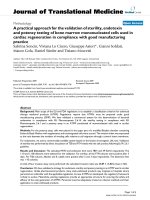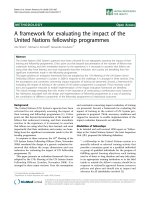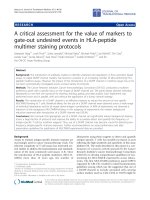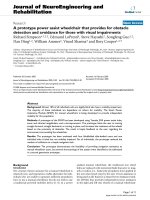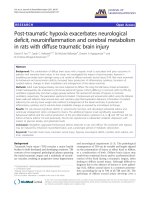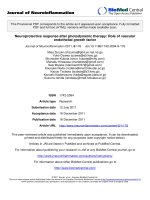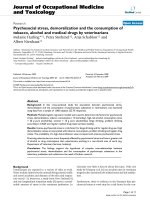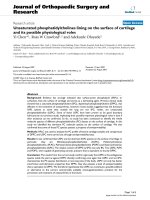báo cáo hóa học:" A lifeline to treatment: the role of Indian generic manufacturers in supplying antiretroviral medicines to developing countries" pptx
Bạn đang xem bản rút gọn của tài liệu. Xem và tải ngay bản đầy đủ của tài liệu tại đây (848.05 KB, 9 trang )
SHORT REPOR T Open Access
A lifeline to treatment: the role of Indian generic
manufacturers in supplying antiretroviral
medicines to developing countries
Brenda Waning
1,2*
, Ellen Diedrichsen
1
, Suerie Moon
3
Abstract
Background: Indian manufacturers of generic antiretroviral (ARV) medicines facilitated the rapid scale up of HIV/
AIDS treatment in developing countries though provision of low-priced, quality-assured medicines. The legal
framework in India that facilitated such production, however, is changing with implementation of the World Trade
Organization Agreement on Trade-Related Aspects of Intellectual Property Rights, and intellectual property
measures being discussed in regional and bilateral free trade agreement negotiations. Reliable quantitative
estimates of the Indian role in generic global ARV supply are needed to understand potential impacts of such
measures on HIV/AIDS treatment in developing countries.
Methods: We utilized transactional data containing 17,646 donor-funded purchases of ARV tablets made by 115
low- and middle-income countries from 2003 to 2008 to measure market share, purchase trends and prices of
Indian-produced generic ARVs compared with those of non-Indian generic and brand ARVs.
Results: Indian generic manufacturers dominate the ARV market, accounting for more than 80% of annual
purchase volumes. Among paediatric ARV and adult nucleoside and non-nucleoside reverse transcriptase inhibitor
markets, Indian-produced generics accounted for 91% and 89% of 2008 global purchase volumes, respectively.
From 2003 to 2008, the number of Indian generic manufactures supplying ARVs increased from four to 10 while
the number of Indian-manufactured generic products increased from 14 to 53. Ninety-six of 100 countries
purchased Indian generic ARVs in 2008, including high HIV-burden sub-Saharan African countries. Indian -produced
generic ARVs used in first-line regimens were consistently and considerably less expensive than non-Indian generic
and innovator ARVs. Key ARVs newly recommended by the World Health Organization are three to four times
more expensive than older regimens.
Conclusions: Indian generic producers supply the majority of ARVs in developing countries. Future scale up using
newly recommended ARVs will likely be hampered until Indian generic producers can provide the dramatic price
reductions and improved formulations observed in the past. Rather than agreeing to inappropriate intellectual
property obligations through free trade agreements, India and its trade partners - plus international organizations,
donors, civil society and pharmaceutical manufacturers - should ensure that there is sufficient policy space for
Indian pharmaceutical manufacturers to continue their central role in supplying developing countries with low-
priced, quality-assured generic medicines.
* Correspondence:
1
Boston University School of Medicine, Department of Family Medicine,
Boston, MA, USA
Full list of author information is available at the end of the article
Waning et al. Journal of the International AIDS Society 2010, 13:35
/>© 2010 Waning et al; licensee BioMed Central Ltd. This is an Open Access article d istributed under the terms of the Creative Commons
Attribution License ( which permits unres tricted use, distribution, and reproduction in
any medium, provided the original work is properly cited .
Background
India has emerged as a world leader in generic pharma-
ceuticals production, supplying 20% of the global market
for generic medicines [1]. The emergence of generic
sources supplying quality antiretroviral (ARV) medicines
at prices much lower than originator prices undoubtedly
accelerated the global scale up of HIV/AIDS treatment.
From 2002 to 2008, more than 4 million people were
started on antiretroviral therapy (ART) in developing
countries [2].
To date, the vast majority of people in low- and mid-
dle-income countries have been treated with generic
ARVs produced by Indian manufacturers unhampered
by patent and other intellectual property restrictions [3].
This absence of intellectual property barriers a lso
resulted in the development of improved ARV formula-
tions, such as paediatric dosage forms and fixed-dose
combination (FDC) ARVs whereby two or more ARVs
are combined into one tablet. As of the end of 2009, the
United States Food and Drug Administration and the
World Health Organization (WHO) Prequalification
Programme approved or pre-qualified 57 adult FDCs
and 31 paediatric ARV tablets produced by Indian gen-
eric manufacturers but only eight adult FDCs and 14
paediatric ARV tablets produced by non-Indian and ori-
ginator manufacturers [4-6].
The intellectual property framework that positioned
India as the “pharmacy of the developing world”,how-
ever, is rapidly changing. In 2005, India was obliged to
amend its patent law to allow product patents on medi-
cines to comply with the World Trade Organization
(WTO) Agreement on Trade Related Aspects of Intellec-
tual Property Rights (TRIPS). The introduction of pro-
duct patents in India is severely constraining generic
competition and supply, particularly for newer medicines.
Now, there is a threat that the limited policy space that
remains will be further constricted by bilateral or regio-
nal free trade agreements. Unfortunately, many free trade
agreements that have been concluded or are being nego-
tiated between industrialized and developing countries
contain measures that restrict access to medicines [7].
Agreements involving India are of particular concern
bec ause of the count ry’s role as a worldwide suppli er of
low-priced generic medicines. For example, current free
trade agreement negotiations between the European
Union and India [8,9] include measures that delay or
restrict competition from generic medicines, including:
patent term extensions beyond the 20 years required by
TRIPS; data exclusivity (that could delay the registration
of generic medicines); and border enforcement measures
that could block international trade in generic medicines
when they are suspected of infringing patents in the
countries through which they transit. These types of
border measures blocked medicines from reaching
patients in Africa and Latin America in 2008 and 2009
when European customs authorities seized Indian-pro-
duced generics transiting via Amsterdam airport on sus-
picion that they infringed Dutch patents [10]. All of
these measures can delay o r restrict co mpetition from
generic medicines and are in direct conflict w ith the
2001 WTO Doha Declaration on TRIPS and Public
Health, and medical ethics [8,9].
A b etter underst anding of the role that Indian generic
medicines producers play in HIV/AIDS treatment in
developing countries will shed light on the potential
consequences of recently proposed intellectual property
measures for global public health. While their relative
importance is widely recognized, reliable quantitative
estimates of generic ARVs supplied by Indian producers
are not available. The purpose of this paper is to quan-
tify the extent to which Indian pharmaceutical manufac-
turers have contributed to HIV/AIDS treatment in
developing countries to bette r understand the potential
implications of current and future policies that may
hamper or restrict ma rket entry of generic ARV manu-
facturers and generic competition.
Methods
We obtained donor-funded ARV purchase transactions
over the 2003-2008 period from the WHO Global Price
Reporting Mechanism, the Global Fund to Fight AIDS,
Tuberculosis and Malaria ’ s Price & Quality Reporting
Tool, and UNITAID as provided by the Clinton Health
Access Initiative [11-14]. Antiretroviral transactional
data was systematically cleaned and validated using a
market intelligence database described elsewhere
[15-17]. We excluded transactions for liquid ARV for-
mulations, which resulted inananalyticdatasetcon-
taining 17,646 donor-funded purchases of ARV tablets
and capsules made by 115 countries (Figure 1).
Market share by volume is calculated in person-years
for Indian generic, non-Indian generic and brand ARVs
using WHO-recommended adult doses for persons
weighing more than 60 kilogrammes (kg) [18,19]. We
provided estimates of producer market share for all
ARVs, but also calculated market share among three
ARV market niches: paediatric ARVs (all classes), adult
nucleoside reverse transcriptase inhibitors (NRTIs) and
non-nucleoside reverse transcriptase inhibitors
(NNRTIs), and adult protease inhibitors (PIs).
We compared purchase trends for Indian generic,
non-Indian generic and brand ARVs, summarizing the
number of manufacturers, products/dosage forms, pur-
chases, purchasing countries and value (in US dollars).
We calculated 2008 antiretroviral regimen prices for the
most commonly used first-line regimens recommended by
Waning et al. Journal of the International AIDS Society 2010, 13:35
/>Page 2 of 9
the WHO in its 2003 and 2006 treatment guidelines for
adults weighing more than 60 kg [18,19]. We expressed
regimen prices as price per person per year. Because most
ARV price distributions were skewed dramatically by a
few high price outliers, we presented regimen prices using
median and quartile prices to accurately convey central
tendencies. W e differentia te regimen composition by
using a “+” when multiple tablets are used to create a regi-
men (e.g., 3TC+NVP+TDF) and a “ /” for FDC formula-
tions (e.g., 3TC/NVP/d4T). We plotted 2003-2008 trends
in generic ARV regimen prices along with those of innova-
tor ARV regimens offered through differential or tiered
prices, as reported to Médecins Sans Frontières (MSF) in
its “Untangling the web of ARV price reductions” [20].
We obtained all ARV pri ces in United State s dollars and
adjusted them to the January-December 2008 period using
the annual US Consumer Price Index [21].
Results
Our results confirm the prominence of Indian generic
manufacturers in the supply of antiretroviral medicines
to developing countries. Since 2006, Indian-produced
generic ARVs have accounted for more than 80% of the
donor-funded developing country market, and c om-
prised 87% of ARV purchase volumes in 2008 (Figure 2).
The proportion of ARVs produced by Indian manufac-
turers is even higher within certain market niches. In
2008, Indian-produced generics accounted for 91% of
paediatric ARV volume and 89% of adult NRTI and
NNRTI purchases (Figure 3). In contrast, originator
companies accounted for the majority (81%) of purchase
volumes f or adult protease inhibitors (PIs), wi th Indian
generics accounting for only 19%.
The value of the donor-funded, developing country
ARV market has exhibited dramatic annual growth over
the past several years. By 2008, Indian generic ARVs
accounted for 65% of the total value (US$463 million) of
ARV purchases reported, while non-Indian generic and
innovator ARVs accounted for 13% and 22% of market
value, respectively (Table 1). The number of Indian gen-
eric manufacturers supplying ARVs to low- and middle-
income countries increased from four to 10 from 2003
to 2008, while the number of Indian-produced generic
ARV products increased from 14 to 53 over the same
period (Table 1).
In 2008, 96 of 100 countries reported ARV purchases
from Indian generic producers, while only 29 countries
reported purchases from non-Indian generic manufac-
turers (Table 1, Figure 4). Most countries reported pur-
chases of innovator PIs whereas far fewer countries
reported generic PI purchases, most likely due to lower
prices offered through tiered pricing schemes for brand
lopinavir/ritonavir in 2003-2008. The number of coun-
tries purchasing Indian-produced generic PIs, however,
has steadily increased over the years as global PI
volumes have increased and generic pricing has become
more competitive with originator tiered prices.
Analysis of Indian-produced generic ARV purchase
trends by country reveal India’ s own reliance on the
availability of generic ARVs as demonstrated by nearly
Figure 1 Description of analytic data set.
Waning et al. Journal of the International AIDS Society 2010, 13:35
/>Page 3 of 9
2200 purchases of Indian-produced generic ARVs
(Table 2) totalling nearly US$26 m illion in 2008.
Volumes associa ted with these purchases were sufficient
to treat more than 200,000 people with first-line regi-
mens and more than 1000 people with second-line regi-
mens. India reported no purchases for non-Indian
generic or innovator ARVs in 2008. Sub-Saharan African
countries with high HIV/AIDS disease burdens comprise
the remaining top 10 purchasers of Indian-produced
generic ARVs (Table 2).
Robust competition among manufacturers has contrib-
uted to sub stantial price reductions for generic ARVs
over the past several years. The most commonly used
first-line adult regimen (lamivudine/nevirapine/
stavudine30) dropped from $414 per person per year in
2003 to $74 per person per year in 2008 for Indian-
produced generics (Figure 5). While regimen prices for
non-Indian generic were similar to Indian generic ARVs
from 2004 to 2006, by 2008 the non-Indian generic
price was two times higher than the Indian generic
price. Innovator prices for this first-line regimen, both
actual prices contained in our database and survey
prices reported to MSF [20], were consistently much
higher than generic ARVs across all years. In 2008,
inno vator regimen prices reported to MSF were 4.5 and
7.7 times higher than Indian generic prices, depending
upon the tiered-price category of the purchasing country
(Figure 5) [20].
Figure 2 Overall ARV market share (volume) for Indian generic, non-Indian generic and originator (brand) manufacturers, 2003-2008.
Figure 3 Adult and paediatric ARV market share (volume) for Indian generic, non-Indian generic and originator (brand)
manufacturers, 2008.
Waning et al. Journal of the International AIDS Society 2010, 13:35
/>Page 4 of 9
Among many concerns around the future of global
ART scale up are higher prices for new WHO-recom-
mended, first-line regimens that utilize zidovudine or
tenofovir in place of stavudine [19,22]. As of 2008, the
Indian generic global median price for newly recom-
mended tenofovir-based regimens ranged from $246 to
$309 per person per year, notably 3.3 to four times
higher than the price of the most commonly used older
regimen (3TC/NVP/d4T30) (Table 3). I dentical regi-
mens, comprised of non-Indian generic and innovator
ARVs, are considerably more expensive than the Indian
generic versions.
Discussion
These analyses quantify and confirm the exceptional
role that India has played in providing quality ARVs at
low prices to people with HIV/AIDS in developing
countries. More than 80% of all donor-funded ARVs
purchased since 2006 were supplied by Indian generic
manufacturers. Price reductions noted for commonly
used historical first-line regimens were a result of robust
generic competition among Indian manufacturers in an
environment largely void of intellectual property barriers
[23,24]. Countries across sub-Saharan Africa with high
HIV/AIDS burdens, as well as India, are heavily reliant
on t he availability of Indian-produced generic ARVs to
support their national treatment programmes.
Trade-related and intellectual property-related threats
to the supply of generic med ici nes from India are com-
ing at a time when the prospects of ART scale up are
already cloudy. New WHO guidelines recommending
early initiation of ART [22] will result in increased
Table 1 Purchase trends for Indian generic, non-Indian generic and originator ARVs, 2003-2008
2003 2004 2005 2006 2007 2008
# Countries reporting any ARV purchase 15 69 86 86 90 100
Indian generic ARVs
# manufacturers 4 8 6 7 9 10
# products/dosage forms 14 31 30 37 47 53
# purchases 62 740 1142 1273 2433 5906
# purchasing countries 11 55 70 78 81 96
NRTIs 11 53 66 74 80 92
NNRTIs 6 51 65 63 75 93
PIs 4 17 20 26 31 37
value (USD millions) 0.67 43.84 86.54 93.40 188.08 301.38
Non-Indian generic ARVs
# manufacturers 0 2 3 2 3 6
# products/dosage forms 0 5 19 15 18 15
# purchases 0 10 228 124 201 316
# purchasing countries 0 4 10 13 20 29
NRTIs 0 2 9 11 20 25
NNRTIs 0 2 4 3 6 5
PIs 0010 0 0
value (USD millions) 0 0.12 27.38 3.72 14.34 58.76
Originator ARVs
# manufacturers 6 8 8 7 7 8
# products/dosage forms 18 32 33 39 40 39
# purchases 35 654 1146 976 1284 1116
# purchasing countries 8 50 75 77 79 88
NRTIs 4 40 57 66 63 57
NNRTIs 4 31 52 36 22 14
PIs 4 32 58 67 73 82
value (USD millions) 1.64 29.80 74.39 56.51 83.02 102.62
Waning et al. Journal of the International AIDS Society 2010, 13:35
/>Page 5 of 9
numbers of people in need of treatment. At the same
time, countries ar e trying to adopt the new ARV regi-
mens recently recommended by WHO [19,25]. These
newer ARVs offer better side-effect and tolerab ility pro-
files,butsomeofthekeyARVsaremorewidely
patented and are much more expensive than regimens
used in the past. These WHO changes are welcome and
help eliminate historical inequities whereby people in
resource-poor countries receive a differe nt standard of
care than those in rich countries. However, country
budgets within the Global Fund to Fight AIDS,
Tuberculosis, and Malaria have been c ut [26], while
pledges and contributions appear flat, raising concerns
that funds will not be available in-country to adopt the
new WHO recommendations [19,22,25].
Limitations
Our study captures only donor-funded purchases and not
those made by government-funded HIV/AIDS treatment
programmesthroughsuchcountriesasBrazil,South
Africa and Thailand. Similarly, we had no access to com-
prehensive and reliable data on patents and other
Figure 4 Countries reporting purchases of Indian generic ARVs in 2008.
Table 2 Summary of Indian-produced generic ARVs for countries with highest 2008 purchase volumes
Purchase
volume rank
Country % of ARV volume supplied by
Indian generic producers
Value of Indian- produced generic
ARV purchases (USD million)
# Indian-produced generic ARV
dosage forms purchased
1 India 100 25.9 14
2 United Republic of
Tanzania
96 27.3 13
3 Nigeria 84 27.1 28
4 Ethiopia 96 27.6 24
5 Mozambique 99 15.3 16
6 Zambia 94 20.7 19
7 Namibia 99 15.3 23
8 Democratic
Republic of the
Congo
99 11.4 25
9 Kenya 82 10.2 14
10 Cameroon 93 15.0 30
Waning et al. Journal of the International AIDS Society 2010, 13:35
/>Page 6 of 9
Figure 5 Price trends for generic 3TC/NVP/d4T30 (fixed-dose combination) and innovator 3TC+NVP+d4T30 (3 individual tablets),
2003-2008. *Survey prices provided by innovator companies under tiered-pricing [20]. **2003 price is for three individual ARVs (1
st
FDC
purchase reported in 2004).
Table 3 First-line ARV regimen prices comparisons, 2008
Indian generic
median price
(25
th
,75
th
)
Non-Indian generic
median price
(25
th
,75
th
)
Innovator actual
median price
(25
th
,75
th
)
Innovator survey
price**
Cat 1, Cat 2
First-line regimens from 2003 WHO
guidelines:
3TC/NVP/d4T30 74
(63, 88)
154*
(137, 712)
N/A 331, 570
EFV+3TC/d4T30 131
(126, 193)
229*
(196, 656)
N/A 349, 789
3TC/NVP/ZDV 120
(118, 123)
142
(142, 142)
519*
(496, 991)
444, 663
EFV+3TC/ZDV 183
(177, 260)
326
(254, 348)
491
(475, 801)
434, 854
New first-line regimens from 2009 WHO
guidelines:
3TC+NVP+TDF 246
(230, 273)
340
(321, 767)
575
(519, 1254)
490, 867
EFV+3TC+TDF 298
(283, 369)
415
(381, 711)
546
(498, 1064)
508, 1086
FTC/TDF+NVP 257
(247, 301)
387
(386, 537)
641
(569, 1116)
538, 986
EFV+FTC/TDF 309
(300, 397)
461
(446, 480)
612
(548, 926)
556, 1205
N/A insufficient sample size to estimate price
*regimen prices calculated by summing up prices of 3 component ARVs
**Médecins Sans Frontières, “Untangling the web of ARV price reductions ” [22]
Waning et al. Journal of the International AIDS Society 2010, 13:35
/>Page 7 of 9
intellectual property barriers and were, therefore, una ble
to quantitatively examine these issues in our study. While
we systematically cleaned and validated all transactional
data, we cannot be confident that we have identified all
reporting errors in publicly available data. Prices are
inconsistently reported to the Global Fund and the WHO
Global Price Reporting Mechanism. Whereas some orga-
nizations, such as UNITAID and the Supply Chain Man-
agement System arm of the United States President’s
Emergency Plan for AIDS Relief, provide prices for drug
costs only, Global Fund-supported countries often report
prices that include not only drug costs, but also add-on
costs, such as transport, insurance and taxes.
We attribute ARV price reduction primarily to generic
competition, but we note that these price decreases
were also spurred through the efforts of HIV/AIDS acti-
vists, civil society organizations, national governments,
foundations and other international organizations.
Despite these limitations, our research provi des valu-
able quantitat ive information demonstrating the critical
role that Indian generic pha rmaceutical manufacturers
play in the global treatment of HIV/AIDS in developing
countries. These results can and should be used in
ongoing and future discussions around intellectual prop-
erty and access to medicines.
Conclusions
Free trade agreements that may create new intellectual
property obligations for I ndia can increase ARV prices,
impede the development of acceptable dosage forms,
and delay access to newer and better ARVs. Such mea-
sures can undermine the international goal to achieve
universal access to HIV/AIDS interventions and the
2001 WTO Doha Declaration on TRIPS and Public
Health [25]. Rather than agreeing to inappropriate intel-
lectual property obligations, India and its trade partners
- along with international o rganizations, donors,
national governments, civil society and pharmaceutical
manufacturers - should ensure that there is sufficient
policy space for the Indian generic industry to continue
its central role in supplying developing countries with
low-cost, quality-assured generic medicines.
Acknowledgements
This research was financed by the United Kingdom Department for
International Development. The authors thank Jenny Hochstadt for data
management support, and Kajal Bhardwaj, Benjamin Coriat, Leena
Menghaney and Ellen ‘t Hoen for comments provided on earlier versions of
the manuscript.
Author details
1
Boston University School of Medicine, Department of Family Medicine,
Boston, MA, USA.
2
UNITAID, Geneva, Switzerland; Utrecht University, Utrecht,
Netherlands.
3
Sustainability Science Program, Center for International
Development, Harvard Kennedy School of Government, Cambridge, MA,
USA.
Authors’ contributions
BW designed and coordinated the study, participated in data cleaning and
data analysis, and was the lead author on this paper. ED performed data
cleaning and data analysis. SM contributed to data analysis, writing of the
manuscript, and editing for important content. All authors read and
approved the final version of the manuscript.
Competing interests
The authors declare that they have no competing interests.
Received: 22 April 2010 Accepted: 14 September 2010
Published: 14 September 2010
References
1. Perlitz U: India’s pharmacuetical industry on course for globalisation. Frankfurt
2008.
2. World Health Organization, UNAIDS, UNICEF: Towards universal access:
Scaling up priority HIV/AIDS interventions in the health sector. Progress report
2009. Geneva 2009.
3. Médecins Sans Frontières: Untangling the web of antiretroviral price
reductions [ />4. World Health Organization: Health Systems and Services: Prequalification of
Medicines Programme [ />5. President’s Emergency Plan for AIDS Relief: Approved and Tentatively
Approved Antiretrovirals in Association with the President’s Emergency Plan .
6. United States Food and Drug Administration: Drugs @ FDA: FDA Approved
Drug Products [ />index.cfm].
7. Correa C: Implications of bilateral free trade agreements on access to
medicines. Bull World Health Organ 2006, 84(5):399-404.
8. Von Schoen-Angerer T: Letter to Karel de Gucht, European Commissioner
for Trade. [ />medinnov_accesspatents/MSF%20letter%20to%20Trade%20Commissioner%
20April%202010.pdf].
9. De Gucht K: Letter to Tido von-Schoen-Angerer, Executive Director, MSF
Campaign for Access to Essential Medicines
10. Abbott F: Seizure of generic pharmaceuticals in transit based on
allegations of patent infringement: a threat to international trade,
development and public welfare. World Intellectual Property Organization
Journal 2009, 1:43.
11. UNITAID. [ />12. William J: Clinton Foundation: Treating HIV/AIDS and malaria. [http://
www.clintonfoundation.org/what-we-do/clinton-health-access-initiative].
13. World Health Organization: Global price reporting mechanism [http://www.
who.int/hiv/amds/gprm/en/].
14. Global Fund to Fight AIDS, Tuberculosis and Malaria: Price & Quality
Reporting [ />Lang=en-GB].
15. Waning B, Kaplan W, King A, Lawrence D, Leufkens H, Fox M: Global
strategies to reduce the price of antiretroviral medicines: evidence from
transactional databases. Bull World Health Organ 2009, 87(7):520-528
[ />16. Waning B, Kaplan W, Fox M, Boyd-Boffa M, King A, Lawrence D, Soucy L,
Mahajan S, Leufkens H, Gokhale M: Temporal trends in generic and brand
prices of antiretroviral medicines procured with donor funds in
developing countries. J Gen Med 2010, 7:159-175.
17. Waning B, Kyle M, Diedrichsen E, Soucy L, Hochstadt J, Bärnighausen T,
Moon S: Intervening in global markets to improve access to HIV/AIDS
treatment: an analysis of international policies and the dynamics of
global antiretroviral medicines markets. Glob & Health 2010, 6(9) [http://
www.globalizationandhealth.com/content/6/1/9].
18. World Health Organization: Scaling up antiretroviral therapy in resource-
limited settings: treatment guidelines for a public health approach, 2003
revision. Geneva 2004.
19. World Health Organization:
Antiretroviral therapy for HIV infection in adults
and adolescents in resource-limited settings: towards universal access. Geneva
2006.
20. Médecins Sans Frontières: Untangling the web of antiretroviral price
reductions Geneva: Médecins sans Frontières, 4-11 2003.
21. International Monetary Fund: World Economic Outlook Database.
Washington DC 2010.
Waning et al. Journal of the International AIDS Society 2010, 13:35
/>Page 8 of 9
22. World Health Organization: Rapid advice: antiretroviral therapy for HIV
infection in adults and adolescents. Geneva 2009.
23. Ford N, Wilson D, Chaves GC, Lotrowska M, Kijtiwatchakul K: Sustaining
access to antiretroviral therapy in the less-developed world: lessons
from Brazil and Thailand. AIDS 2007, 21:S21-S29.
24. ’t Hoen E: The Global Politics of Pharmaceutical Monopoly Power: Drug
Patents, Access, Innovation and the Application of the WTO Doha Declaration
on TRIPS and Public Health Diemen: AMB Publishers 2009.
25. World Health Organization: Prioritizing second-line antiretroviral drugs for
adults and adolescents: a public health approach. Geneva 2007.
26. Paton W: Communication to all CCMs and PRs on 10% savings on round 8
Geneva: Global Fund to Fight AIDS, Tuberculosis and Malaria 2008.
doi:10.1186/1758-2652-13-35
Cite this article as: Waning et al.: A lifeline to treatment: the role of
Indian generic manufacturers in supplying antiretroviral medicines to
developing countries. Journal of the International AIDS Society 2010 13:35.
Submit your next manuscript to BioMed Central
and take full advantage of:
• Convenient online submission
• Thorough peer review
• No space constraints or color figure charges
• Immediate publication on acceptance
• Inclusion in PubMed, CAS, Scopus and Google Scholar
• Research which is freely available for redistribution
Submit your manuscript at
www.biomedcentral.com/submit
Waning et al. Journal of the International AIDS Society 2010, 13:35
/>Page 9 of 9

